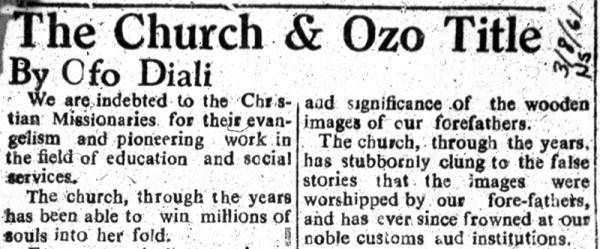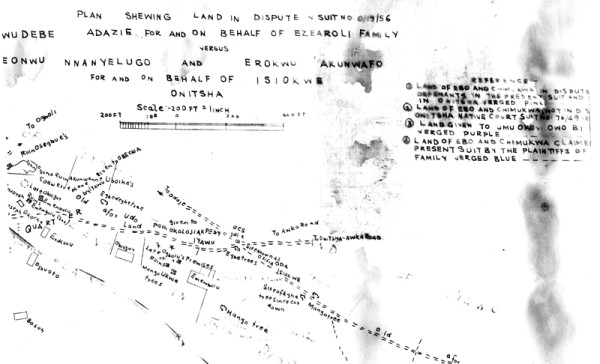Shortly after Obi Okosi II’s death, as candidates from Umu-EzeAroli emerge in varying degrees of prominence, numerous other village groups (and other kinds of Ndi-Onicha organizations) also begin actively discussing problems of succession . At first most people focus mainly on the question of what seems to be happening among the three main sub-villages of Umu-EzeAroli, where events are moving so swiftly and with obviously visible if uncertain results. But as Enwezor’s supporters continue to break through supposedly established normative boundaries, more formal developments begin to occur throughout the Inland Town.
1. Isiokwe Villagers: pursue Obiship?
One pivotal source of leadership comes from the numerically quite small royal subclan of Isiokwe, of which Byron Maduegbuna is a member and Helen and I (in our research good luck) have become informally attached. Having Byron as our sponsor is in many ways a boon richer than we deserves, because (as we gradually learn) he occupies a position that is in some ways unique in all of Onitsha. The first relevant feature of his status (and the only one to be considered here) is his position as Secretary of Isiokwe Village itself, for while he has real ambitions to further his Western education in order to succeed in Nigerian professional life, Byron is also deeply committed to life as a traditional Onitsha man, and his role in Isiokwe reflects this fact. Moreover, Isiokwe is not merely a rather small group of families defined as a minor village of the larger village unit of Odoje (though it is that): it has importance well beyond its size.
According to a broadly accepted genealogical legend, the founding ancestors of Isiokwe Village were three brothers of King Aroli, the four together being sons of the early Onitsha King named Chima-Ogbuefi (“Chima-the-Cowkiller”] : 1:
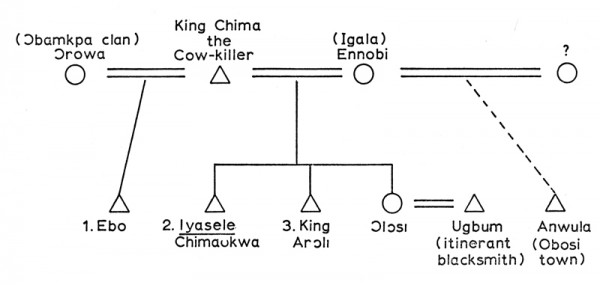
The three brothers of Aroli were Ebo, Chima-ukwa, and Anwula. Since two of these brothers were senior to Aroli (or as it was more frequently put, since Aroli was “the youngest son”), Isiokwe people, the descendants of these three brothers, hold the permanent position of Diokpala (Senior Lineage Priest) for all Umu-Chima-Ogbuefi. This means that on any occasion when a meeting is called for all to assemble, the senior priest of Isiokwe claims the right to occupy the patrilineage throne of Chima-Ogbuefi and give the ritual blessings which will sanction any decisions made by the group. Onitsha people put it to me as an outsider steeped in Western categories, that while a chief is the “political” leader of his village, the senior priest (at the level of a Village) is the “spiritual” leader, but the latter is as essential to decision making as the former in the sense that his presence is required to morally validate the assembly itself. 2
Senior Priesthood however has different social implications at different levels of descent group organization. Within a co- residential and regularly co-worshipping group, the priesthood is a position of pivotal power that regulates control over both residence and farm lands, linking such control to a wide range of ritual processes that serve to define the meaning of each member’s self as well as one’s access to the everyday means of existence (including negative rights like the requirement of exogamy binding upon both male and female members of the group). At higher, more community comprehensive levels, the priesthood’s estate becomes both less comprehensive and more intangible, though it remains highly significant in community politics.
At the high level of descent group commonality which binds the people of Isiokwe with Umu-EzeAroli , past separations traced to events in legend have considerably diminished the stock of mutual obligation: long ago the people of Isiokwe and the descendants of Eze-Aroli “scattered the ghosts,” that is, ceased their regular worship together and broke off such pivotal reciprocities of lineage mates as the sharing of Ozo title money. 3
Indeed, the two sub clans no longer share the bond of exogamy, and Isiokwe has established its own village membership within the major village of Odoje, whose other members are people of non-royal clans. Similarly, the Umu-Olosi (“Children of Olosi“], the third major sub group among the Umu-Chima-Ogbuefi, has become a unit within the otherwise non-royal Ogbe-Oli (Village of Oli) (though they retain close relations for some purposes with Isiokwe, including shares of Ozo title money). 4
However, in 1960 Egbunike the Onya and the other members of the Umu-EzeAroli Peace Committee are using this mutually-acknowledged common ancestry from Obi Chima-Ogbuefi as the basis of the land claim they have decided to press against the people of Isiokwe. Since, they argue, both groups are fellow “Umu-Chima-Ogbuefi“, therefore both the people of Isiokwe and the Umu-EzeAroli should share Isiokwe’s ancestral farm land, which is “land of the Senior Lineage Priest,” to be enjoyed equally by all children of the entire lineage. As Byron Maduegbuna tells me at the beginning of the Interregnum, the implications of this claim are clear to Isiokwe people: since Umu-EzeAroli outnumber Isiokwe by a ratio of three or four to one, should the former win the pending court case they will in future gain control of most of the monetary proceeds deriving from this land (or perhaps to a substantial portion of the land itself).
The undeniable fact that Isiokwe people are, and will in theory forever be, in some senses the Senior Priests to their brother sub-clansmen of Umu-EzeAroli (should occasions arise when all members of Umu-Chima-Ogbuefi will meet, Isiokwe must preside) in any event opens doors to unknown possibilities of legal reasoning. When the case is listed on the Onitsha High Court docket a few days after the death of Obi Okosi II, local members of Isiokwe express apprehension and anger. Byron, who as Secretary of Isiokwe Family is repeatedly involved in its most intimate affairs, had previously told me about this impending land case, showing me the maps being employed by both sides while expressing his fears of their opponents’ vastly greater powers in money and numbers.
Below, part of the map outline of this land case brought by Umu-EzeAroli against Isiokwe, a copy of which Byron provides me. It is indeed derived directly from the 1949 land case that Isiokwe won against Obosi people (who at that time had claimed the land), with the new claim merely inserted within it.
When I first learn about this litigation being brought against Isiokwe, based on land tenure rules specified by many informants of diverse village backgrounds, I find difficult to imagine any valid grounds Umu-EzeAroli might have for bringing it at all it. Since the “ghosts had been scattered” well back in the previous century (with the many separations of everyday life that this dispersion entailed), it would be far-fetched by native law and custom to claim that the two groups might still share their farm land (joint lineage land tenure being by definition grounded in the common veneration of ancestral ghosts and the sharing of exogamy). However, the people of Isiokwe greatly fear the case, because of the money and power that stands behind the Umu-EzeAroli Peace Committee. (As Byron Maduegbunam is always telling me, “We are few in number.”)
Court case decisions in Nigeria in the early 1960s do not however consistently hinge on what Onitsha elders agree are the historically most salient facts of the dispute, and the European charged with this particular case, Judge Betuel, is not well informed about Onitsha laws (at a party at the home of the prominent Onitsha barrister Chuba Ikpeazu, I hear him state authoritatively in another context the preposterous claim that Onitsha inheritance law is defined by a simple rule of “primogeniture”). This situation of vast ignorance of “Native Law and Custom” on the part of the judges means that legal decisions are likely to be based more on communications among knowledgeable lawyers and the judge involved in the particular case, than on any considerations of “Native Law and Custom”.
A few days after Obi Okosi II’s demise, when Byron is recounting to me some of the rumors he has heard of the meetings now being held among Umu-EzeAroli he says:
“You can never rely on Umu-EzeAroli. They will never be able to back a suitable man. They are trying to steal our land. You know, we of Isiokwe may decide to re-activate our old rights to the kingship. We are thinking about who we can put up as a candidate.”
Byron discusses these possibilities with several Isiokwe men, and they decide it is time to activate Isiokwe‘s accepted position of seniority within the Royal Clan in order to gain some leverage in the kingship contest. Nnanyelugo Melifonwu, the Senior Priest (Diokpala) of Isiokwe (and therefore also the Senior Priest of all Umu-Chima-Ogbuefi) , directs Byron to invite all other segments of the Royal Clan to attend a meeting at Isiokwe Village on February 12, “to discuss matters of pressing importance.”
As we have become co workers with Byron in our project aimed at studying Onitsha history, and with the Interregnum, we also are in a sense participants in a sequence of events in which a major outcome of this history is being forged. So we discuss with Byron how we will deal with the fact of his own imminent active entry into the interregnum arena, and Byron says he will keep us fully informed of the proceedings, of which he plans to take written minutes. Helen and I observe that it would be useful to those participating to have typed minutes, and offer our services for that purpose. After consulting with the pivotal elders, Byron agrees to this plan, and in this way we gain access both to his subsequent recounting of the activity and to the formal records he keeps of the proceedings. We are also able to check the minutes he keeps against the recollections of other participants. In return, Byron obtains our (mainly Helen’s) secretarial assistance for his tasks of keeping appropriate records for the groups in which he becomes involved.
The Isiokwe elders hastily draw up invitations to various sub clans within the Umu-Eze-Chima, but the people of Okebunabo, an entire major division of the Royal Clan, are at first excluded. An obvious (and formally valid) rationale Byron gives me for this is that, since their leaders are still absorbed in preparing for the king’s funeral, they are “too busy” preparing for the King’s funeral, but I sense that their intentions are also feared, and Isiokwe leaders think it wise to keep them uninformed at least at the outset of deliberations.
2. Isiokwe calls out”all Umu-Eze-Chima”
The meeting of February 12, 1961 in Isiokwe Quarters becomes the first of a series of conclaves called by Isiokwe during February and early March prior to the king’s funeral, which they regard as secret gatherings of the “Royal Clan” (Umu-EzeChima), despite the fact that numerous segments of the Royal Clan are not initially represented. The problem of representation has not in fact yet been overtly raised; indeed, at first only a few people from Umu-Aroli Village and Ogbeozala Village join the Isiokwe elders in these gatherings, the Aroli lineage representatives being accompanied by their advisors (sometimes including the Peace Committee’s current legal advisor, Barrister Luke Emejulu, who waits outside and gives advice to these persons from time to time).

Based on the “minute” sketches Byron conveyed, the proceedings on these several occasions follow a typically recurrent course. As the most senior priest present, Nnanyelugo Melifonwu declares the meeting open and presides over the serving of kola nuts and drinks. (Note that, although he is Diokpala of Isiokwe and therefore of this part of the Royal Clan, Nnanyelugo Melifonwu suffered a stroke some time ago and is unable to act effectively in any controversial actions. He therefore is mainly important for his presence; others dominate any discussions while he mostly remains silent.)
Then the people of Ogbeozala and Umu-Aroli (two major branches of Umu-EzeAroli) begin to argue with one another over the question of which candidates are suitable and whose turn it is now to provide the next successor to the throne. The names of various potential candidates from Umu-EzeAroli are introduced and discussed.
For example, a participant from Umu-Aroli offers the name of Enwezor, and someone from Ogbeozala stands up in response and enumerates Enwezor’s disqualifications. Members of Ogbeozala offer alternative names (Ediboss, Onyejekwe, and Odita are some early ones mentioned), each of whom is then dismissed as unfit by other individuals from Umu-Aroli. On one occasion, a member of Ogbeozala produces a putative historical document purporting to certify that it is now their turn next to produce a king; the men of Umu-Aroli dismiss the testament as invalid.
In the first meeting, one elder suggests that perhaps someone from the absent major Royal Division (Ôkebunabo) may have learned about this gathering and has planted Disagreement Medicine (akpa-esese) somewhere on the premises. But the basic difficulty soon becomes quite clear: these participants from Umu-EzeAroli are deeply divided over the issue of succession.
When during these early discussions it appears that the elders of Umu-EzeAroli have reached an impasse, an Isiokwe elder rises to speak and suggests that Isiokwe itself can produce a candidate who is better than any mentioned so far and who will prove suitable to all sides. At first the Umu-EzeAroli express great skepticism about this prospect, but by the third meeting they suggest that Isiokwe produce their candidate at the next gathering of the group.
At that subsequent session, one Umu-EzeAroli elder (prompted from outside by Barrister Emejulu) emphasizes that their previous encouragement of Isiokwe was only a “Gentleman’s Agreement,” and is “not legally binding.” Their somewhat ambiguous receptivity to Isiokwe’s candidacy, however, sufficiently encourages the latter group that they should conduct a serious search within their ranks to identify a plausible candidate for the throne.
After each meeting Byron and I briefly discuss the results as reflected in the minute books. He expresses the view that members of Umu-EzeAroli were attending the meetings partly because there is real disagreement over candidates within the group, and partly because they believe they must now show appropriate respect to the call of Isiokwe‘s senior priest in view of the pending land litigation. From Isiokwe‘s perspective, he says, we will do our utmost to use our seniority leverage, with the aim of establishing our right to candidacy. (Left unsaid was the prospect that Isiokwe might be hoping to gain enough leverage over the interregnum process that the land case would be dropped, or on the other hand the very probable likelihood that some Umu-EzeAroli participants might be attending solely as spies.) My own contribution in these discussions is mainly to express to Byron my great interest in what was transpiring, to ask questions where the minutes seem to me unclear, and to encourage him to continue the work (which is at this point my clearest window into the interregnum process).
3. Isiokwe seeks one of their own
Isiokwe is the first Inland Town village where I have conducted a partial census of the residents, and one of the most remarkable patterns I find there is a sharp contrast between the older and younger generations of married men. They differ sharply of course in incidence of polygyny (most seniors have several wives, most junior married men only one), but more surprisingly also in the frequency of marriage to women from outside Onitsha town. While the older men have lavishly blended non-Onitsha women into their homes (many from Obosi town), the younger ones mostly marry Onitsha women. Byron Maduegbuna explains to me that Onitsha people have learned a lesson from this formerly popular practice of communal exogamy during the early 20th century, claiming for example, that the Onitsha sons of Obosi women tend to care more for Obosi than for Onitsha as they grow up. 5) .
In addition to the census, I manage to obtain through Byron access to the Isiokwe Family Minute Books (Byron as Secretary has found himself involved in an internal litigation opposing the senior priests to some “young Turks” of Isiokwe, and fears someone from the young-Turk side might try to steal them from him, so he lends them to me “for safe-keeping”), and by attending many of their rituals I am able to get a fairly detailed sense of their descent group dynamics.
Anyone familiar with the internal affairs of Isiokwe in the early 1960’s would doubt their capacity to unite at this time behind any single candidate. Although their opposition to Umu-EzeAroli is shared among all, they are torn by a markedly vigorous internal dissension which includes both a factionalism between historically senior lineage segments and wealthy “upstart” ones,, 6 and in addition a substantially crosscutting and also intense conflict between senior, tradition-emphasizing elders and educated, mostly younger men, over the disposition of communal lands.
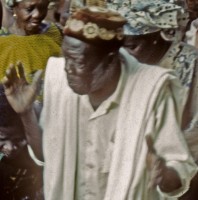
Byron in his role as Isiokwe Family Secretary stands firmly with the dominant active Senior Priest of Isiokwe (also the reigning Senior Priest of Byron’s own major subdivision of the descent group, Enekwizu segment), Akunwafor Erokwu, a former Court Clerk now aged in his 70’s who possesses great stores of traditional knowledge, very strong will, and is not only widely admired for his wit but is also accorded wide respect for what Byron called his “knowledge of the Black Arts”. Akunwafor Erokwu sees as a major duty in his current tenure as Isiokwe‘s main (effective) Senior Priest (See the note above regarding Melifonwu.) the prevention of a rise to power by an opposing lineage segment, the Uwechia Family, which possesses a disproportionately large number of prominent professional (and relatively young) men relative to that of his own (and Byron’s) segments. So determined is Akunwafor Erokwu to define them as “upstarts” that he omits their ancestor’s name from the Isiokwe genealogy in his authoritative ritual recitals of it, and he also seeks to retain decision-making authority over the current negotiations for leasing of Isiokwe Family lands under his own directing hand.
 Prominently opposing Akunwafor Erokwu is Doctor Lawrence Uwechia (who served as one of the main initial facilitators of our Onitsha fieldwork), a man famous in Nigeria for his post-WWII pioneering distribution of antibiotics that, for example, healed disfiguring diseases like Yaws. But now, as head of the Public Service Commission of the Eastern Region Government, he is much too engaged in bureaucratic work to maintain continuous contact with home events.
Prominently opposing Akunwafor Erokwu is Doctor Lawrence Uwechia (who served as one of the main initial facilitators of our Onitsha fieldwork), a man famous in Nigeria for his post-WWII pioneering distribution of antibiotics that, for example, healed disfiguring diseases like Yaws. But now, as head of the Public Service Commission of the Eastern Region Government, he is much too engaged in bureaucratic work to maintain continuous contact with home events.
Nonetheless, Dr. Uwechia is seeking to make the (effective) Senior Priest of Isiokwe accountable to all members of Isiokwe for his substantial financial dealings with funds deriving from Family lands. He is trying to transform the descent group into a more modern type of organization (one more closely approximating a joint holding company) with decision making about land leasing more broadly distributed through the group and funds more responsibly administered. Akunwafor Erokwu stoutly resists these moves, and a substantial number of the younger educated men have recently joined Dr. Uwechia in bringing the issues to a court case now being organized against the Senior Priest. Byron justifies his support of the effective Senior Priest both on the grounds of his respect for ancestral law and sanctions, and of his fear of the reach toward dominating power in Isiokwe by Uwechia family, which threatens his own (currently dominant) segment of the descent group.
In view of my grasp of Isiokwe Family politics, I feel sure that they will have plenty of trouble deciding on a Kingship candidate whom all segments of the Family can support. However, at a Family Meeting held toward the end of February, when his lineage priest offeres the name of Akunnia Moses Emembolu, an Ozo titled man from Akunwafor Erokwu’s section of the lineage, introducing him as a man of regal bearing who has expressed his desire for the throne, this arouses considerable interest in the group. Although a representative of Uwechia Family tries to forestall any discussion of particular names at this early stage (prior to the King’s funeral), the suggestion to wait is rejected, and the senior elders agree to send Akunnia Emembolu a directive to report home to Onitsha for further consultations. They mandate the rest of the group to visit their confidants from other villages in the Inland Town to mention his name, sound out his reputation, and get some indication of how strong his potential support might be.
I learned that Uwechia sub-family have proposed a potentially much stronger and apparently also interested candidate in the person of Nwabufo Uwechia, a man of very considerable reputation who holds the influential post of Advisor to the Customary Court system of Eastern Nigeria, so this rush to confirm Emembolu, whose career apex was that of Manager of the Bookshop of the Church Missionary Society in the somewhat remote Ndi-Igbo town of Mbawsi, seems at least premature. I am informed however that everyone in Isiokwe understands the situation: no Isiokwe candidate would have any chance whatever without firmly unitary support, and there seems to be fairly wide consensus that no candidate from Uwechia family (however prominent and distinguished he might be) could mobilize such unity.
When Byron Maduegbuna tells me of the family’s decision, he expresses strong confidence that Isiokwe could win with this kind of candidate. I ask him what sort of people he and his kinsmen will now most want to consult in order to gain wider support. He replies:
“We will go to the people, prepare (Emembolu) to meet the Ndichie (chiefs). We can count on two Ndichie. We of Isiokwe are fortunate to have some very fine Nwa-di-Ani (Daughter’s Children) in the town. Because we are few in numbers we pet our (Daughters’ Children) very much, and they are always for us. Nzekwu, the Omodi of Umu-Ase, is Nwa-di-Ani to Isiokwe, and he is the senior brother of Anatogu the Onowu (The Prime Minister of Onitsha). Omodi is a retired senior Collector of Customs, and he is very rich, in fact he has financed Anatogu — he bought the car Anatogu is driving, and Anatogu always takes his advice. And the Onowu will be happy to have a King from Isiokwe. Such a small village has no time to think ill of anybody; our Obi will agree with the Onowu.”
Byron adds that Isiokwe will consult Nzekwu, whose Omodi title designates him also as the prestigious Eze-idi (“Hidden King”) of Umu-Ase during the coming week to learn how best to approach his Prime Minister brother.
“Then there is Mbamali, the Ajie (Second Minister), of Umu-Olosi. He is always for us. When he wanted to make Ajie (title), he came with a goat and palm wine to inform us. We gave him £30. When he does anything, we help him. We are most fortunate of all villages in Onitsha, that our (Daughter’s Children) are important personalities and take delight in us.”
4. Ajie Mbamali redefines “Umu-Olosi”
When I learn that Byron intends to visit the Ajie at his home in Fegge Waterside one afternoon, I offer to give him a ride there in my car. I had met the Ajie with Byron on January 3 and had enjoyed an interesting conversation with him at that time, when He explained to me how his ancestress, Olosi, had been the most senior child of Chima-Ogbuefi, how she would have been King had she been a man, and how his great grandfather the Fifth Minister, Ogene EzeOba, had become so powerful during the late 19th century that he had actually competed for glory with Obi Anazonwu and had even overshadowed him for a time.
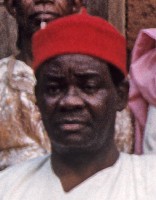
Now wanting to learn more about Ogbe-Oli-Olosi, a major village which the Ajie administers, I hope to hear about their duties during the forthcoming Obi Okosi II burial, their views of the interregnum, and to confirm some information about the group that I have heard from outsiders. For example, I have been told by several sources that when the ancestress Olosi married, her brother Eze Aroli directed her to occupy the hill to the east of his palace, with the result that afterwards her descendants lived on the edge of the “town”; this was the reason the Umu-Olosi were also referred to by the term Iru Obodo, which means “Face of the Town.”
We drive down to the Fegge Layout, Waterside and enter the Ajie’s extensive walled compound, dominated by his spacious, modern two storey house. (He is the only one among the six Senior Chiefs of Ndi-Onicha whose regular residence is located outside the Inland Town, though he retains his paternal Ancestral House in the Ogbe-Oli-Olosi for ritual use. For a Senior Chief to live away from the matrix of indigenous Onitsha social life constitutes a substantial break with tradition and is a source of some criticism.)
Ushered inside by a servant, we are left to wait in the dark coolness of a well furnished parlor. After a few minutes, the Ajie comes downstairs, a large and strikingly handsome man in his fifties clad in a fine white gown. He greets us cordially and inquires how I am enjoying my stay in Onitsha; then, as we sip cool drinks of orange crush, the Ajie begins to talk, with a tense excitement in his voice.
“Do you know what happened this week? We went to Ozi (reputed to be the oldest titled man in Onitsha, and an icon in his time, regarded as a very deep fountain of truth), and we learned that we Umu-Olosi once had a king who reigned in Onitsha! I was astonished! We went to him because we wanted to find out why it is we Olosi have the task to bury the king; Ozi told us that the father of the Ogbe-Oli-Olosi was a man named Obodo, who actually reigned as king in the olden times. His senior son was named Iru; that is why they call us Iru Obodo. Later, there was a mistake, someone kept these facts from us. I wouldn’t have believed it, but Ozi and Amene, the two oldest men in Onitsha, both say it is true.”
While Bryon and I avoid each other’s gaze and strive to digest this unprecedented genealogical information, the Ajie proceeds to discuss problems of kingship succession. He observes that two sections of the Royal Clan — Umu-EzeAroli and Okebunabo — have for many years been the strongest in numbers, and thus they always claim that only they have the right to provide kings. But a proper system of succession has so far not been evolved. Isiokwe still has a valid claim, and so do the Umu-Olosi. Furthermore, it is improper (he says) to begin selecting a new king before the old king has been buried, but by their current actions the Umu-EzeAroli are obviously trying to usurp the title by force. It is true they appear to have a candidate, but many people in the Royal Clan are now writing letters to the Ajie, telling him that this man was not properly selected.
If, the Second Minister continues, it is indeed true that the Umu-Olosi are actually the most senior village among all the Umu-EzeChima since Obodo was Eze Chima‘s senior son, then the Umu-Olosi should be consulted about any selection that might be made. Indeed, the Umu-Iru-Obodo might now decide to call a meeting of the entire Royal Clan to discuss the matter.
“Don’t forget (he concludes) that as (Second Minister) of Onitsha I am already the official political head of all the Umu-EzeChima, and in that capacity I have the right to summon them together. We will ask other families in the (Royal Clan) to put up their candidates for the kingship. In fact, my family wants me to stand for it, but I refuse. I won’t take it unless the people demand me to do it. But what we need is a hard working, progressive man.”
When Byron and I take leave of the Second Minister’s house, we each voice states of mild shock. Clearly, it is the prerogative of the most senior chief of any clan or village to take charge of any plenary non-ritual meetings (provided the most senior lineage priest is present to legitimize the convening of the group). The Ajie is in fact the most senior chief of the entire Royal Clan (second as an Ndichie-Ume only to the non-royal Prime Minister), and a meeting of that group is an end toward which the people of Isiokwe also have been striving. But the Ajie‘s oral tradition is totally new to both of us (so Byron affirmed, though I later find a version of it presented in testimony during a 1947 litigation held in the Onitsha Native Court): the genealogical “primacy” of Olosi that the Ajie stated is by no means “common knowledge.” The Ozi however is a highly respected sage, not given to fanciful creations of genealogy. Byron finally manages to make a joke about “King Obodo” (a figure entirely new to our imaginations), but we both agree that the Ajie‘s open assertiveness implies that the Umu-Olosi have decided to embark upon a strong course of action, which adds a new dimension to the struggle.
5. “Ofo Diali” of Ogbe-Ozala speaks forth
As various parties make preparations for the formal Announcement of Obi Okosi II’s demise, a headline appears in the “Vox Pop” section of the Nigerian Spokesman on March 8 1961:
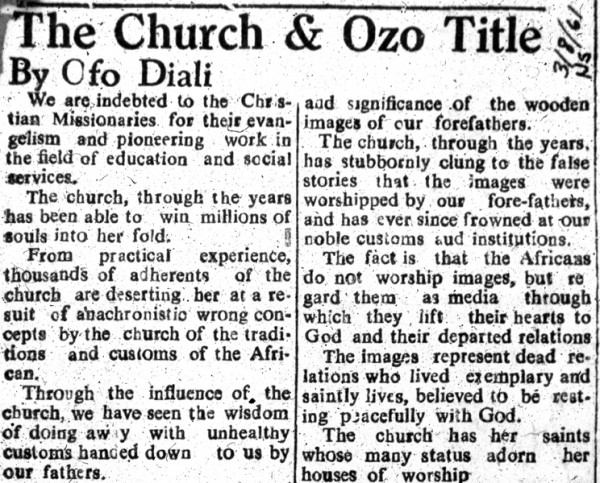
“Ofo Diali” designates this writer as a senior patrilineage elder of the descendants of the prince “Diali”, or “Odiari”, whom early Missionaries described as Obi Akazua’s senior son and who as the leader of Ogbe-Ozala defeated the Ogbe-Ndida pretender during the Interregnum of 1872-3 (only to die in the smallpox epidemic of that time) (See the Genealogy of Umu-EzeAroli for details.) Moses Odita, most prominent figure among the Umu-EzeAroli men touted as worthy of kingship, is a direct descendant of this historic chief and the person the missionaries there at the time labeled “rightful successor” to the throne in 1872-3.
After thanking the Christian Missionaries for their “evangelism and pioneering work”, the author observes that now , “thousands of adherents of the church are deserting her as a result of anachronistic wrong conceptions by the church of the traditions and customs of the African.” He observes that some of “our noble and worthy customs” are being neglected “because of subtle war by the church against these customs”, one of which is the Ozo title. This has long been attacked by church dignities, who (he says) regard the Ozo is “an Abomination in the sight of God” because like other native ritals it involves “idolatry”, and they excommunicate any of their members who take the title.
The author then argues that the church has misconstrued much of African rituals, which in fact enable people to “lift their hearts to God”. (By “the church” he of course refers to the Roman Catholic Mission in Onitsha (and not the Anglican CMS, which had long allowed its adherents to take the title). “Ofo Diali” would appear to refer to Akunnia Mbanefo, a highly respected elder of Ogeozala and a man closely associated with prospective candidate Moses Odita.
To anticipate some later findings, I here attach a copy of the genealogy later submitted by Mr. Odita in support of his candidacy:
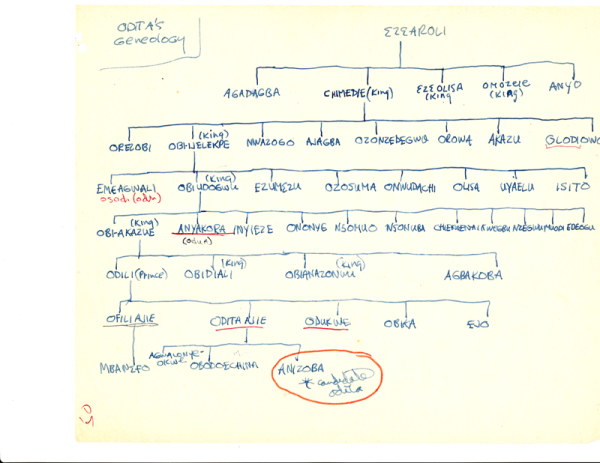 In terms of royal lineage sequencing, this is the most impressive genealogy I will ever encounter in Onitsha. Moses Odita is a direct patrilineal descendant of Obi Akazua (shown here as “Akazue”), through his senior son Odili (who the missionaries in 1865 regarded as Akazua’s presumptive successor, but who died of an illness during that year), while his surviving brother (here labeled “Obi“) Diali began the necessary steps toward succeeding Akazua after the latter’s death in 1872 but also died during that process. 7 Both Odili and Odiali are thus central figures in the history of UmuEzeAroli‘s control of the Kingship, and Moses Odita must be viewed as a very serious candidate.
In terms of royal lineage sequencing, this is the most impressive genealogy I will ever encounter in Onitsha. Moses Odita is a direct patrilineal descendant of Obi Akazua (shown here as “Akazue”), through his senior son Odili (who the missionaries in 1865 regarded as Akazua’s presumptive successor, but who died of an illness during that year), while his surviving brother (here labeled “Obi“) Diali began the necessary steps toward succeeding Akazua after the latter’s death in 1872 but also died during that process. 7 Both Odili and Odiali are thus central figures in the history of UmuEzeAroli‘s control of the Kingship, and Moses Odita must be viewed as a very serious candidate.
6. Enter Peter Achukwu, Age-Grades, and the Onitsha Improvement Union
By this same time (the end of February), I hear various rumors that Peter Achukwu is becoming involved in the kingship problem. Bryon learns for example that members of Uwechia Family in Isiokwe have visited Achukwu to sound him about the possible candidacy of Nwabufo Uwechia, which offends Byron considerably since an Uwechia candidacy would directly compete with that he has in mind for Moses Emembolu. He is also concerned because other people are apparently encouraging Achukwu to “form one of his organizations,” a worrisome possibility: “We don’t want him to take over with his ‘confusionist’ tactics,” Byron says.
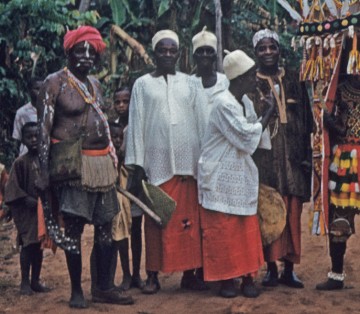
Mentioning the name of Peter Aniweta Achukwu seldom brings mild responses in Onitsha in my experience. The most common adjective used to describe him in Onitsha English is “wonderful,” a literal translation of an Igbo phrase which however does not necessarily entail the positive connotations this word has in English. The Igbo phrase “O di egwu” is translated “He is wonderful,” but the intended meaning is a literal one, “full of wonder”, meaning “astonishing, amazing”, implying that the person will assay, and perhaps accomplish unexpected, improbable (but not necessarily desirable in the view of the speaker) feats. The reference to “confusionist” tactics also connotes a heightened fear of the potential chaos associated with introduction of uncertainty, innovation in the face of efforts to follow established procedures. When these words are used with reference to Achukwu, I usually sense a combination of admiration, envy, and sometimes resentment and fear on the part of the speaker. Sometimes a person will say, “We used to fear him” (the “used to” denoting a continuing-perfect tense not otherwise to be rendered in English, equivalent to the statement “It used to be cold in Jos”, referring to perceived chronic weather conditions on that plateau — “It has been (and continues to be…”).
There are good reasons for this exaggerated respect, for he is a most unusual man. Because he plays a significant role in several parts of our text, and a good sense of his character and accomplishments requires extended exposition, I have provided an essay elsewhere: see Chapter 7, the page “Some Exemplars……
So when I learn that Achukwu may be taking an active interest in the kingship process, I drive to his house along the Awka Road in Ogbe-Oli-Eke (“Village of Oli Eke”) to visit him. There, Achukwu tells me that a number of people have indeed come to him expressing their interest in the kingship and protesting against the activities of Umu-EzeAroli. He adds that “Mr. Enwezor’s supporters” “are ignoring Onitsha community,” and argues that the interests of this entire community should be primary in considering who the next king should be:
“We have lost our rights in our lands, and our rights to tribute from both the government and the mercantilists, all because we have had the wrong King since 1900. We must get back these rights with our new King.”
A “real candidate” is not yet in evidence, he says:
“We want a cultured person, an educated man, one who has complete self respect; we want Onyekwesiliekwesi — a man who is entirely fit according to native law and custom.”
In order to accomplish this, he adds, he is planning to bring all Onitsha Inland Town “Commoners” (Agbala na iregwu, “Those who Support and Dignify”) together in a meeting with members of the Onitsha Improvement Union, in order to reorganize the OIU into the main political body of Onitsha. So as to ensure mass participation, all the Onitsha age sets will be invited to send representatives. Since Isaac Mbanefo, the Odu (Third Minister of Onitsha), is the most senior surviving leader of the Onitsha Improvement Union’s Home Branch, he will be called upon to act as Pro tem Chairman until new leaders could be selected.
This meeting does indeed occur on March 2, and is attended by representatives of OIU from various stations abroad. An account of it appears in the Eastern Observer (but curiously, not in the Spokesman), phrased mostly in general terms. Speakers reportedly criticized the absence of “a spirit of communal effort among Onitsha people,” and more specifically attacked the recent social activities of Onitsha age Grades:
“Mr. Peter Achukwu described age grades as cultural societies which interest themselves only in ‘merry making.’ He suggested the founding of a central union embracing all age grades. This suggestion received the support of many members including Chief Mbamali the Ajie.”
After stressing the prospect of forming a “Central Union of Onitsha people,” “The meeting adjourned after taking many decisions”. 8
It never becomes clear to me just what these decisions were, though Achukwu speaks confidently afterwards about the program of a forthcoming meeting, which will, he says, focus on defining a proper Constitution, a formal document laying down the laws governing the next king of Onitsha (copies of previous versions of which, spearheaded by himself, he later provides me from his files, the earliest dating to 1938). In the days that follow I wait to hear about the next meeting of this potential mass movement, but the announcement and funeral of the king intervenes, and afterwards this group never organizes in the way Achukwu initially planned. (Note how he appears to have aimed at taking the reins out of the hands of various segments of the Royal Clan, a worthuy effort but hardly likely to succeed given the early dynamism of various Royal groups.)
7. Stirrings in Umu-Ase, a Major Village among Non-Royal Clans
Although most of the interregnum activity of which we learn prior to the king’s funeral involves members of the Royal Clan, the non-royal groups are not entirely quiescent. On February 27, I visit a man who has become one of my favorite consultants, Akunne F. I. Oranye, a highly respected elder aged 75 years from Umu-Ase, a man who enjoyed a long and fruitful government service career dating back to 1906 and who possesses both excellent memory and outstanding reputation for forthright truthfulness.
Receiving me at his home in the New American Quarter of Onitsha Waterside, he tells me that his daughter’s husband, Nnanyelugo Joseph Onyejekwe, has written him from Lagos saying that he intends to retire from the Nigerian Police force in order to contest the kingship, and requests his wife’s father’s support and assistance. Oranye says that Onyejekwe, a member of Ogbe-Ozala now living in Lagos as an Assistant Superintendant of Police, is also communicating with the Onitsha Improvement Union branches located abroad, presenting to them his qualifications and seeking their support. Now he wants Oranye to begin paving the way for him at home and the old man was beginning that task.
I ask Akunne what he plans to do to help his son in law. He says he has already privately consulted with some of his fellow Ozo title holders, and that he plans (as Onyejekwe had specifically requested) to go this evening up to Ogbe-Ozala to meet with some of the important elders and also some of the youths in order to find out what is going on there. Akunne Oranye says he intends to tell them that the man whom Umu-EzeAroli are supposedly supporting is not fit; how could he talk in the Eastern House of Chiefs, since he has no tongue? Enwezor has given many of the old men “dash” (bribe money), Oranye says, and they are supporting him, but the young men are more interested in Onyejekwe. (I have in fact heard the latter’s name in a number of contexts, and the most positive comments are being made by young men.) But everything must remain secret for now, he says; Onyejekwe has advised him not to approach the chiefs yet, but to go instead “among the masses” and sound out the potential of his support.
As I take leave of him, Akunne Oranye volunteers that
“We held a meeting this week, to decide what we will do about the kingship this time. You know in 1931-35 different sections of our family gave Ofo to different candidates; some people did it for money. So far we have decided that, after the announcement of the king’s death, we Umu-Ase will demand that the Ofo held by Anazonwu family since 1900 be returned to us. Then we, the Kingmakers of Onitsha, will decide who we will give Ofo to.”
As the traditional symbol of acceptance of the king’s authority bestowed by the non- royal clans, this Ofo, the ofo otutu (“Anvil ofo“) is according to tradition to be retained among the Umu-Ase during each interregnum. 9 However, when Obi Anazonwu died in 1899 and the subsequent selection process was manipulated away from his lineage by officials of the British Government and the Roman Catholic Mission, the Anazonwu family withheld both this staff and the Royal Nze, refusing to cede either to the new Obi from Okebunabo, and leaders of Umu-Ase subsequently resorted to various ad-hoc arrangements (including the fabricating of several new Ofo sticks by various parties in the village, and their conferral to competing candidates during the 1931-35 interregnum). This generated conflicts and schisms within Umu-Ase, producing a factionalism which they now apparently intend to resolve at the outset, before demands for their ritual support are actively made. The scheduled meeting would of course require the presence of Isiokwe Village’s own Nwa-di-Ani (Daughter’s Child), Nzekwu the Omodi (whose status as “Hidden King” of Umu-Ase makes him its most sacred and senior lineage priest).
8. Measuring oppositions
As I drive back to our home in the Inland Town, I realize the implications of what Akunne Oranye was saying: the succession process has in a sense barely begun. At a time still well before the King’s official “dying”, it has seemed to me (and to many others in Onitsha, both Ndi-Onicha and Ndi-Igbo) that the contest had been virtually won by Enwezor and his supporters. During the last week of February and the first week of March, word spreads throughout the Inland Town that the Onya and other senior elders of Umu-EzeAroli had sent a letter communicating their “Resolution of Unanimous Support for Enwezor” not only to the Prime Minister of Onitsha (the Onowu) but also to the Premier of the Eastern Nigeria Government and to various of its Ministers and Secretaries. The information about Enwezor’s selection is thus now being discussed not merely in the Inland Town but in government circles throughout Eastern Nigeria and no doubt at the national level as well. If the regional Government should decide to act swiftly, Enwezor might receive formal recognition soon after the King’s funeral was held, and the prospect of a long Onitsha interregnum would thereby be avoided.
This early news of the Umu-EzeAroli Resolution being forwarded to the Regional Government had an impact on all of the social developments described in this chapter. The last meeting of Isiokwe with Umu-EzeAroli prior to the funeral ends in the pall of this information; Mbamali the Ajie and Peter Achukwu mention it when I speak with them; I hear it almost wherever I go. What strikes me most now, however, is the sense of offense expressed in these responses. Some, like Achukwu, speak moderately that the action was “improper.” Others are far more emphatic, and once again I hear the charge of “Abomination” (alu) leveled against Umu-EzeAroli (in this case attacking the premature written communication of the king’s death to outsiders entailed by a formal Resolution of this kind).
As Ndi-Onicha temporarily set aside their secret meetings to prepare for attendance at the king’s funeral, it is clear that in some quarters of the Inland Town, wills to resist the Enwezor movement are already hardening, and steps are being undertaken to activate that opposition. Equally striking is the apparent diversity of sources from which opposition might come. Still, I am scarcely prepared for the burst of organizational activity that will follow the funeral’s conclusion, during that subsequent traditional “Time of Rest” (of seven four-day Igbo weeks), only after which (some members of the traditional Onitsha community insist) the succession contest should legitimately begin.
- Genealogy is here drawn from Henderson 1972:448 [↩]
- Henderson 1972:411;418-20;448-50 deals with some of the history of Isiokwe and its fellows in this regard. [↩]
- In the phrase “scattering the ghosts” they allude to the separation of the collected Okpulukpu (Treasure Boxes) said to comprise the abode of specific titled ancestors, formerly held in one shrine by the accepted Senior Lineage Priest of the descent group but now divided among diverse altars. See Henderson 1972:249 50. [↩]
- On the split of Isiokwe and Umu-Olosi from Umu-EzeAroli, see Henderson 1972:449-50. [↩]
- And In fact, I observe notably ambiguous views of the recent Obosi riots on the part of such men; see Chapter 3, “Newcomer’ Experiences and Wider Realities”. [↩]
- See Henderson 1972:420-438 for extended discussion of “upstart lineages” and conflict. [↩]
- See Henderson 1972:454-7 for an account of this historical sequence. [↩]
- Eastern Observer, March 10, 1961. [↩]
- See Henderson 1972:268-9 for discussion of the history and significance of the “Anvil Ofo“. [↩]
